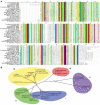Genome mining for methanobactins
- PMID: 23442874
- PMCID: PMC3621798
- DOI: 10.1186/1741-7007-11-17
Genome mining for methanobactins
Abstract
Background: Methanobactins (Mbns) are a family of copper-binding natural products involved in copper uptake by methanotrophic bacteria. The few Mbns that have been structurally characterized feature copper coordination by two nitrogen-containing heterocycles next to thioamide groups embedded in a peptidic backbone of varying composition. Mbns are proposed to derive from post-translational modification of ribosomally synthesized peptides, but only a few genes encoding potential precursor peptides have been identified. Moreover, the relevance of neighboring genes in these genomes has been unclear.
Results: The potential for Mbn production in a wider range of bacterial species was assessed by mining microbial genomes. Operons encoding Mbn-like precursor peptides, MbnAs, were identified in 16 new species, including both methanotrophs and, surprisingly, non-methanotrophs. Along with MbnA, the core of the operon is formed by two putative biosynthetic genes denoted MbnB and MbnC. The species can be divided into five groups on the basis of their MbnA and MbnB sequences and their operon compositions. Additional biosynthetic proteins, including aminotransferases, sulfotransferases and flavin adenine dinucleotide (FAD)-dependent oxidoreductases were also identified in some families. Beyond biosynthetic machinery, a conserved set of transporters was identified, including MATE multidrug exporters and TonB-dependent transporters. Additional proteins of interest include a di-heme cytochrome c peroxidase and a partner protein, the roles of which remain a mystery.
Conclusions: This study indicates that Mbn-like compounds may be more widespread than previously thought, but are not present in all methanotrophs. This distribution of species suggests a broader role in metal homeostasis. These data provide a link between precursor peptide sequence and Mbn structure, facilitating predictions of new Mbn structures and supporting a post-translational modification biosynthetic pathway. In addition, testable models for Mbn transport and for methanotrophic copper regulation have emerged. Given the unusual modifications observed in Mbns characterized thus far, understanding the roles of the putative biosynthetic proteins is likely to reveal novel pathways and chemistry.
Figures






Similar articles
-
Characterization of a Copper-Chelating Natural Product from the Methanotroph Methylosinus sp. LW3.Biochemistry. 2021 Sep 28;60(38):2845-2850. doi: 10.1021/acs.biochem.1c00443. Epub 2021 Sep 12. Biochemistry. 2021. PMID: 34510894 Free PMC article.
-
Methanobactins: from genome to function.Metallomics. 2017 Jan 25;9(1):7-20. doi: 10.1039/c6mt00208k. Metallomics. 2017. PMID: 27905614 Free PMC article. Review.
-
Methanobactins: Structures, Biosynthesis, and Microbial Diversity.Annu Rev Microbiol. 2024 Nov;78(1):383-401. doi: 10.1146/annurev-micro-041522-092911. Epub 2024 Nov 7. Annu Rev Microbiol. 2024. PMID: 39121541 Free PMC article. Review.
-
Characterization of Methanobactin from Methylosinus sp. LW4.J Am Chem Soc. 2016 Sep 7;138(35):11124-7. doi: 10.1021/jacs.6b06821. Epub 2016 Aug 26. J Am Chem Soc. 2016. PMID: 27527063 Free PMC article.
-
Methanobactins: Maintaining copper homeostasis in methanotrophs and beyond.J Biol Chem. 2018 Mar 30;293(13):4606-4615. doi: 10.1074/jbc.TM117.000185. Epub 2018 Jan 18. J Biol Chem. 2018. PMID: 29348173 Free PMC article. Review.
Cited by
-
Detoxification of mercury by methanobactin from Methylosinus trichosporium OB3b.Appl Environ Microbiol. 2013 Oct;79(19):5918-26. doi: 10.1128/AEM.01673-13. Epub 2013 Jul 19. Appl Environ Microbiol. 2013. PMID: 23872554 Free PMC article.
-
The manifold roles of microbial ribosomal peptide-based natural products in physiology and ecology.J Biol Chem. 2020 Jan 3;295(1):34-54. doi: 10.1074/jbc.REV119.006545. Epub 2019 Nov 29. J Biol Chem. 2020. PMID: 31784450 Free PMC article. Review.
-
Specialized Metabolites from Methylotrophic Proteobacteria.Curr Issues Mol Biol. 2019;33:211-224. doi: 10.21775/cimb.033.211. Epub 2019 Jun 5. Curr Issues Mol Biol. 2019. PMID: 31166194 Free PMC article. Review.
-
Characterization of a Copper-Chelating Natural Product from the Methanotroph Methylosinus sp. LW3.Biochemistry. 2021 Sep 28;60(38):2845-2850. doi: 10.1021/acs.biochem.1c00443. Epub 2021 Sep 12. Biochemistry. 2021. PMID: 34510894 Free PMC article.
-
Methanobactin and the Link between Copper and Bacterial Methane Oxidation.Microbiol Mol Biol Rev. 2016 Mar 16;80(2):387-409. doi: 10.1128/MMBR.00058-15. Print 2016 Jun. Microbiol Mol Biol Rev. 2016. PMID: 26984926 Free PMC article. Review.
References
-
- Semrau JD, Dispirito AA, Yoon S. Methanotrophs and copper. FEMS Microbiol Lett. 2010;34:496–531. - PubMed
-
- Jiang H, Chen Y, Jiang PX, Zhang C, Smith TJ, Murrell JC, Xing XH. Methanotrophs: Multifunctional bacteria with promising applications in environmental bioengineering. Biochem Eng J. 2010;49:277–288. doi: 10.1016/j.bej.2010.01.003. - DOI
Publication types
MeSH terms
Substances
Grants and funding
LinkOut - more resources
Full Text Sources
Other Literature Sources
Molecular Biology Databases
Miscellaneous

